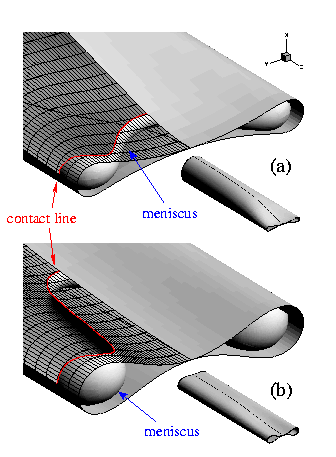Minimal Liquid Bridges in Non-Axisymmetrically Buckled Elastic
Tubes: Results for Finite Surface Tension
For finite surface tension, the pressure jump over the air-liquid
interfaces (the menisci) compresses the tube wall in the region where
it is wetted by the liquid bridge. Two parameters control the collapse
of the tube: (i) the external pressure, (ii) the surface tension.
The figure below shows two strongly collapsed tubes containing
a single minimal liquid bridge. The tube collapses symmetrically
therefore only one half of the tube wall and one meniscus are shown
(the tube was cut in the plane of symmetry at z=0). The large pictures
show a detailed view of the most strongly collapsed part of the tube
with the meniscus; the smaller pictures show the overall deformation
of the tube. Both tubes shown are collapsed to the point where
the opposite walls touch for the first time.

For zero external pressure
[as in Fig. (a)] the tube is only compressed by the surface
tension of the liquid bridge. A relatively large surface tension
is required to cause the strong collapse of the tube. The tube
re-opens quickly
to its undeformed axisymmetric shape as one moves away from the region
which is held in the pinched position by liquid bridge.
Conversely, the tube shown in (b) is compressed by a large
external pressure. Only a small surface tension is required to
deform the tube to the same degree of collapse as in (a).
The tube collapses more uniformly, hence the meniscus finger
is more pronounced than in case (a) (compare to the computations for
zero surface tension).
Back to
`Airway Closure'.
Page last modified: February, 23 1998
Back to Matthias Heil's home page..

